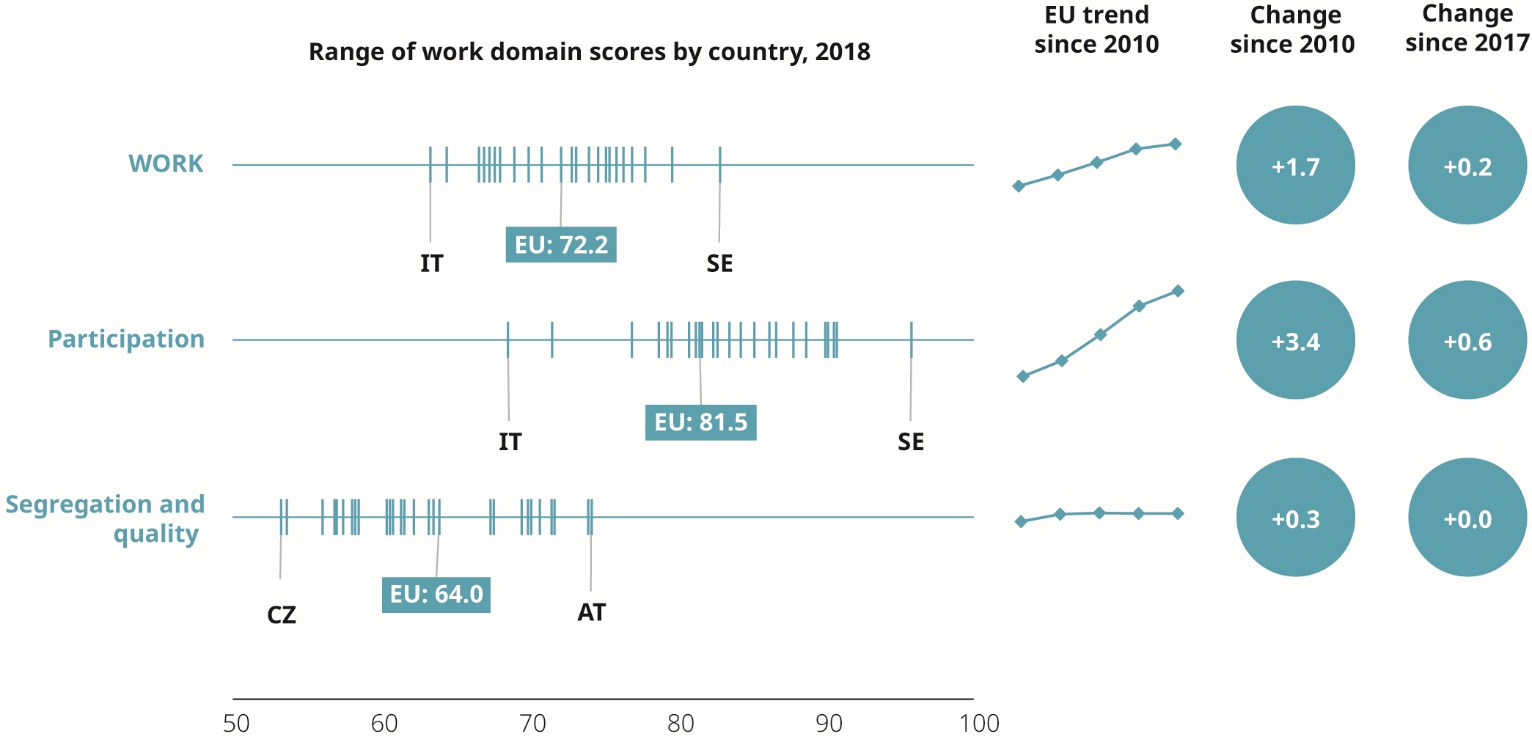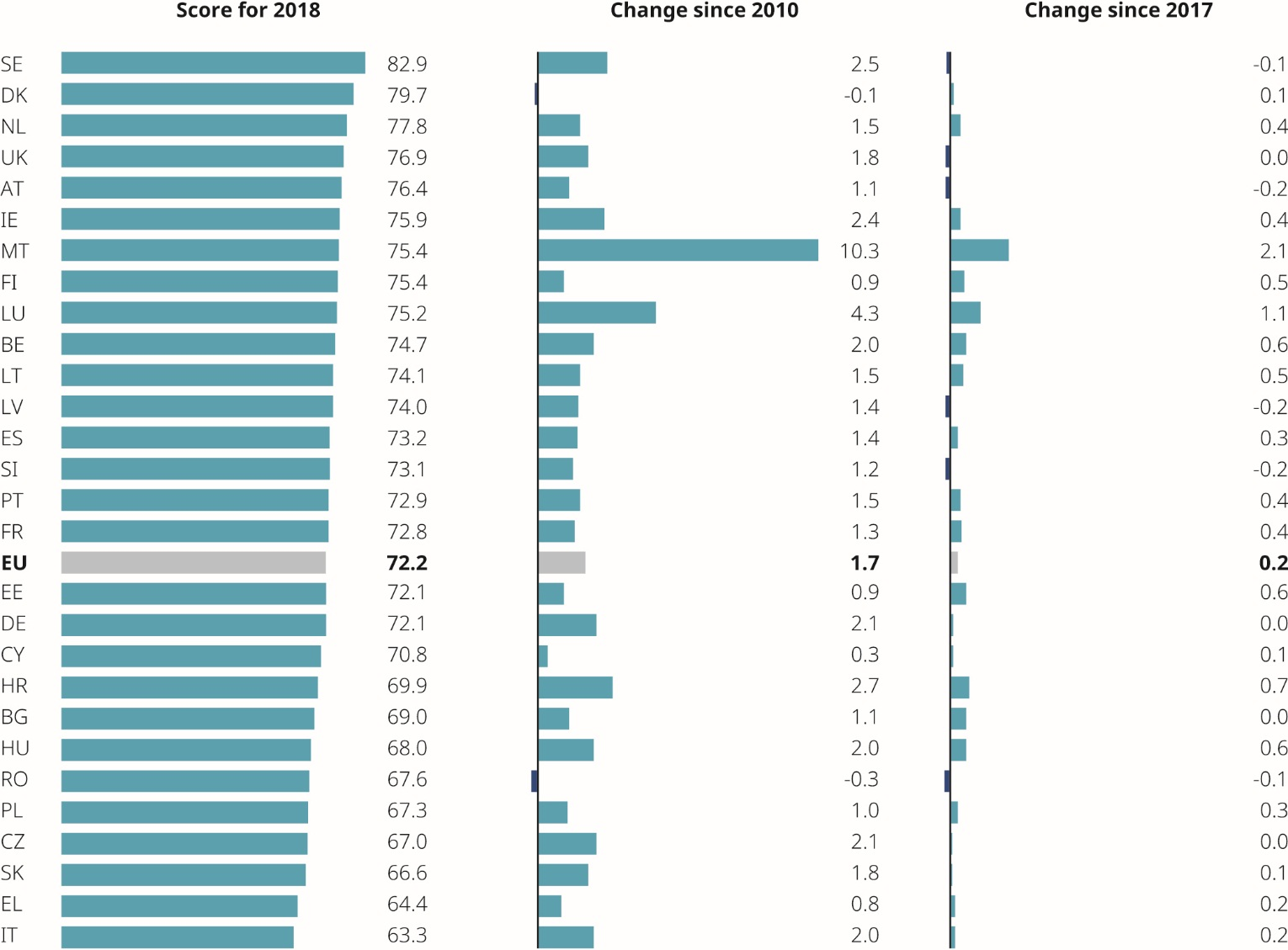Increases in women’s employment have not challenged gender segregation
Gender equality in the world of work is advancing at a slow pace in the EU in both the short term and the long term (Figure 4). On average, the Index score for the domain of work[1] has grown by about 0.2 points per year, reaching 72.2 points in 2018. It may be optimistic to expect this growth to continue, as it is based on a period (2010–2018) characterised by recovery from the 2008 crisis and subsequent (relative) stability, and the latest figures do not take into account the potential implications of the COVID-19 crisis.
Figure 4. Scores for the domain of work and its subdomains (2018), and changes over time
Changes in the work domain scores were almost entirely driven by increases in the labour market participation of women. Since 2010, the Index participation score has increased by about 0.4 points per year, owing to a combination of the following changes.
- The gender gaps in FTE employment rates and duration of working life have reduced slightly. For example, in 2010 women’s FTE employment rate was 17.6 p.p. lower than men’s, and this difference had reduced to 15.9 p.p. by 2018. The gender gap in FTE employment has decreased in 15 Member States, increased in eight and stayed roughly the same in the remaining countries.
- There have been overall increases in the FTE employment rate and the duration of working life for both women and men. For example, between 2010 and 2018 the FTE employment rate increased from 47.2 % to 49 % overall and from 38.9 % to 41.5 % for women.
Preliminary data collected by the European Foundation for the Improvement of Living and Working Conditions (Eurofound)[2] show that the COVID-19 crisis is likely to lead to a sharp decline in employment in the EU. As of May 2020, around 5 % of workers had permanently lost their job owing to the pandemic, 23 % had temporarily lost their job and 15 % believed themselves likely to lose their job in the near future. The International Labour Organization (ILO) estimates that, in Europe and Central Asia, during the first quarter of 2020 working hours declined by 1.9 % , and during the second quarter they were projected to decline by almost 12 % (ILO, 2020b).
The Eurofound data indicates that initial employment losses are likely to affect similar proportions of women and men, although this needs to be considered in the light of limited data reliability and lack of evidence on impacts among specific groups. The proportion of women affected is more striking than in previous crises, such as the 2008 financial crisis, where the immediate impact disproportionately affected men (Alon et al., 2020; ILO, 2020a).
This is partly because the sectors most severely affected by the COVID-19 pandemic (accommodation and food services, real estate, business and administrative activities, manufacturing and wholesale/retail, according to the ILO) account for a sizeable share of women’s employment in the EU, around 40.
Women may also be at increased risk of losing jobs because of additional unpaid care responsibilities resulting from closures of schools and childcare facilities, which may be difficult to combine with employment; this is particularly the case for lone parents, the large majority of whom are women (EWL, 2020). Women are more likely than men to be involved in precarious or informal work, with limited access to various work and social protections, which puts them at a particular disadvantage (EIGE, 2020a; ILO, 2020a).
The progress on women’s participation has not led to substantial changes to gendered patterns of employment in the labour market. The Index score for work quality and segregation has scarcely changed since 2010, standing at 64 points in 2018. Around 30 of all employed women worked in education, health and social work activities, compared with 8 of men.
Other sectors and occupations remain dominated by men: for example, only 17 of ICT specialists are women (see Chapter 9)[3]. Women work more often in certain non-standard forms of employment, such as part-time work (31 of women compared with 8 of men) or temporary work (12 % versus 10 % ), which contributes to higher incidence of precarious employment (26 versus 15) (EIGE, 2020a).
The pattern of slow progress in the domain of work has been fairly consistent across countries since 2010 (Figure 5). Only Malta and Luxembourg have progressed at a substantially faster pace than average. Three countries recorded virtually no improvement in gender equality during this period: Denmark, Romania and Cyprus.
The gender segregation of some occupations came into particular focus during the COVID-19 crisis. Some strands of work were classified as essential during the pandemic, which often exposed these workers to unprecedented workloads, health risks and work–life balance challenges. Around 7 of workers reported a large increase in their working hours during the pandemic[4]. These included health professionals, of whom 72.5 are women in the EU[5].
Women dominate some occupations, especially those often characterised by lower salaries. For example, women account for more than 85 of nursing and midwifery professionals and personal care workers in health services. Another example of a low-paid, female-dominated occupation that became essential during the crisis is food store cashier; these workers faced similar challenges to their health and work–life balance.
Figure 5. Scores for the domain of work, and changes since 2010 and 2017, in the EU Member States

